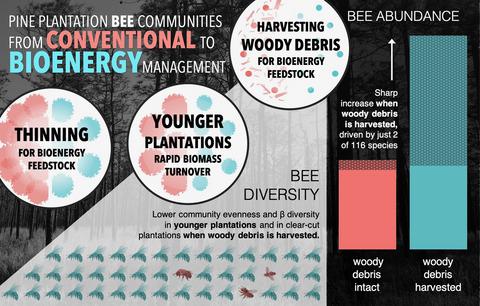当前位置:
X-MOL 学术
›
J. Appl. Ecol.
›
论文详情
Our official English website, www.x-mol.net, welcomes your
feedback! (Note: you will need to create a separate account there.)
The impacts of bioenergy pine plantation management practices on bee communities
Journal of Applied Ecology ( IF 5.0 ) Pub Date : 2020-03-10 , DOI: 10.1111/1365-2664.13586 Xingwen Loy 1 , David Gruenewald 1 , Isabel G. W. Gottlieb 2 , Emily K. Dobbs 1 , Andriana S. Miljanic 1 , Jamieson Botsch 1 , Brice Lawley 1 , Holly K. Ober 3 , Lora Smith 4 , Robert J. Fletcher 5 , Berry J. Brosi 1
中文翻译:

生物能源松树人工林管理实践对蜜蜂群落的影响
更新日期:2020-03-10
Journal of Applied Ecology ( IF 5.0 ) Pub Date : 2020-03-10 , DOI: 10.1111/1365-2664.13586 Xingwen Loy 1 , David Gruenewald 1 , Isabel G. W. Gottlieb 2 , Emily K. Dobbs 1 , Andriana S. Miljanic 1 , Jamieson Botsch 1 , Brice Lawley 1 , Holly K. Ober 3 , Lora Smith 4 , Robert J. Fletcher 5 , Berry J. Brosi 1
Affiliation

|
- Cultivation of bioenergy feedstocks is a growing land‐use world‐wide, yet we have a poor understanding of how bioenergy crop management practices affect biodiversity. This knowledge gap is particularly acute for candidate cellulosic bioenergy feedstocks, such as tree plantations, and for organisms that provide important ecosystem services, such as pollinators.
- We examined bee communities in 83 sites across three states in the southeastern United States—Alabama, Florida and Georgia. We compared bee abundance and diversity in 66 pine plantation sites that reflect management with and without potential bioenergy feedstock production. At least three bioenergy feedstock production methods have been proposed for this region: (a) converting conventional timber stands to short‐rotation bioenergy plantations; (b) harvesting feedstock by thinning conventional plantations; and (c) harvesting of woody debris residues after plantations have been clear‐cut.
- We found that bioenergy‐associated management practices including younger plantations (relative to older) and woody debris removal (relative to debris unremoved) in clear‐cut plantations were associated with reduced bee diversity. Removing ground debris in clear‐cut plantations also drastically increased bee abundance, though this effect was largely driven by strong dominance of just two bee species. Clear‐cut plantations had lower beta diversity than standing plantations.
- Synthesis and applications. Management practices associated with bioenergy feedstock production can have negative effects on bee community diversity. In particular, harvesting of debris in clear‐cut plantations dramatically reduces bee diversity. Large‐scale bioenergy feedstock production that increases the prevalence of young and clear‐cut stands may cause landscape‐level beta diversity to decline. Nevertheless, bioenergy pine plantations likely support higher bee diversity than corn fields, an alternative bioenergy feedstock.
中文翻译:

生物能源松树人工林管理实践对蜜蜂群落的影响
- 在世界范围内,生物能源原料的种植正在增长,但我们对生物能源作物管理实践如何影响生物多样性的了解甚少。对于候选纤维素生物能源原料(例如人工林)和提供重要生态系统服务的生物(例如传粉媒介)而言,这种知识差距尤为严重。
- 我们检查了美国东南部三个州(阿拉巴马州,佛罗里达州和乔治亚州)的83个地点的蜜蜂群落。我们比较了66个松树人工林中蜜蜂的丰度和多样性,这些蜜蜂反映了有和没有潜在生物能源原料生产的管理。该地区至少提出了三种生物能源原料的生产方法:(a)将常规木材林分转变为短轮转生物能源人工林;(b)通过疏伐常规人工林来收获原料;(c)清除人工林后收获木屑残渣。
- 我们发现,与生物能源相关的管理措施,包括较年轻的人工林(相对于年长的人工林)和清除未修剪的人工林中的木屑清除(相对于未清除的残渣),都与减少蜜蜂的多样性有关。清除砍伐的人工林中的地面碎屑也大大增加了蜜蜂的丰度,尽管这种影响很大程度上是由两种蜜蜂的强势主导所致。明确的人工林比常规人工林的β多样性低。
- 综合与应用。与生物能源原料生产相关的管理实践可能对蜜蜂群落多样性产生负面影响。特别是,在砍伐的人工林中收获碎片会大大降低蜜蜂的多样性。大规模生物能源原料的生产会增加幼林和明确林分的流行,可能导致景观水平的β多样性下降。尽管如此,生物能源的松树种植园可能比玉米田(一种替代的生物能源原料)支持更高的蜜蜂多样性。











































 京公网安备 11010802027423号
京公网安备 11010802027423号